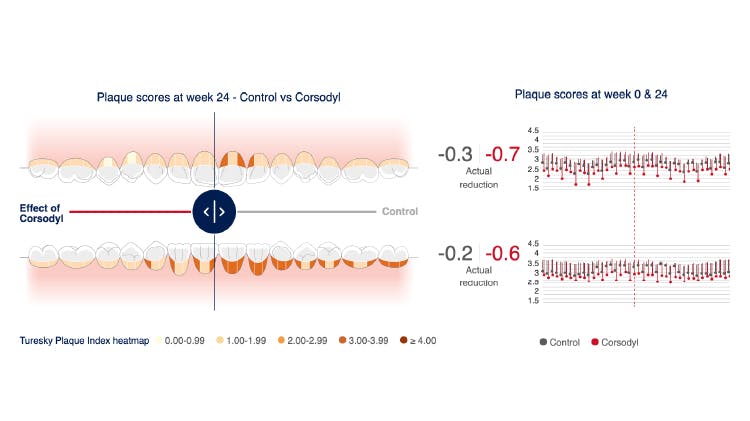Gum Health: Impact on patient quality of life

Gum disease and unhealthy gums can affect patients in unexpected ways
To help prevent the progression of gum disease it is important to understand more about patients’ attitudes towards the condition, uncovering what they may think and feel, but may not talk about. At Haleon, Corsodyl commissioned research amongst gum disease sufferers to understand the condition from their point of view including the impact it has on their lives and their associated behaviours.1,3,4 Research highlighted that gum disease has both physical and emotional impacts including impacts on social interaction and quality of life, especially as symptoms become more severe.1
Unfortunately, patients often focus on teeth ahead of gums when it comes to oral health and may not always act on symptoms of gum disease.1 43% of people ignore or put up with their symptoms.4 In addition, they can fail to associate them with the condition and can create myths to rationalise the problem, for example, they can attribute bleeding to over brushing.1
As dental professionals, your patient care makes the difference. Your advice is the number one opportunity for patients to learn about and treat gum disease. By engaging patients further, you can help them identify any symptoms and create the link between daily oral hygiene and healthy gums and teeth.1
Read on to find out more about patients’ views on gum disease.
Patients may experience anxiety as they progress through the symptoms of periodontal disease and gum issues3

Early signs and symptoms
Research revealed there are a range of signs and symptoms that people experience with gum disease, from bleeding gums and bad breath, to tooth loss, but the link between the symptom and the disease is not often made.1
The early signs and symptoms of periodontal disease are often ignored and anxiety creeps in over time, prompting feelings of isolation as patients deal with it alone.3
Bleeding gums
The first and continuing sign of periodontal disease is bleeding gums, often while brushing or flossing teeth.2 As bleeding symptoms can pass quickly and are often experienced privately, sufferers may ignore the problem or misattribute the cause.1
It is worth tackling the myths around bleeding gums, highlighting to patients that bleeding, however minor, is not normal and is worth preventing though effective OHI.2

Halitosis and gingival recession
Halitosis and gingival recession are bigger concerns for patients than bleeding gums1, but fear of the dentist is common, further hindering seeking professional help.3 Patients may adopt a range of coping mechanisms to avoid bleeding, discomfort or embarrassment including not brushing, avoiding certain foods, or avoiding close contact.1
Halitosis
Symptoms such as bad breath or bleeding can lead to a lack of self-confidence or concern in social situations.1 There are a range of behaviours people adopt to avoid embarrassment such as always carrying a toothbrush, chewing gum, or spraying cologne to mask the smell of bad breath.1
Your understanding, support, and advice on how to manage the sensitive subject of bad breath and halitosis can help your patients understand how to take control of their problem.
Gingival recession
Whilst many people do understand that receding gums can be caused by gum disease, or ineffective brushing, there are a significant proportion that believe the cause is ageing.5

Once periodontitis is reached
It may be too late to prevent tooth loss once periodontitis is reached, causing patients to experience devastation and shock.3
Periodontitis
People intuitively know something is wrong before they are diagnosed. The moment the patient is delivered the news is a moment they will never forget. Most are shocked, some feel anger, guilt, or disbelief, but some are relieved that they now know what is wrong with them.3
It is a time for change, when, with the right support, patients can be motivated to move on, take control and change their oral care behaviour.3
Tooth loss
This is the stage in the patient journey that causes most devastation, as they feel a sense of loss and feel part of their life has gone.3
Patient Centred Care and Behaviour change
Your support and help can make the difference in helping stop and prevent progression. Corsodyl has been working with behaviour change professionals and patients to find out how – collectively – we can inspire the habits that improve gum health and help prevent gum disease.
The Sound of Periodontitis
This film tells the story of the patient’s experience of periodontitis. It was first shown at EuroPerio 8, and was a collaboration between the British Society of Periodontology and the British Society for Dental Hygiene and Therapy, led by the UCL Eastman Dental Institute with support from the UCL Public Engagement Unit.6
Poor periodontal health is linked to systemic disease.2
Periodontitis has been reported to be associated with several systemic diseases, although it is currently unclear whether it can cause them. Research is currently being carried out into the relationship between 57 different systemic diseases and conditions and periodontal disease.7
Periodontal inflammation may compromise the barrier function at the gingivae, leading to infiltration of bacteria into the systemic circulation, and this is thought to be what impacts patient health.2
It is widely accepted that there is a bi-directional relationship between diabetes and periodontitis and that periodontal disease is more prevalent and severe in those with diabetes.7 There is mounting evidence that periodontitis is a risk factor for future CVD and that treating severe gum problems can help to reduce systemic inflammation.8
Read more about gum disease and general health on the European Federation of Periodontology website.
Help your patients on their journey to optimal gum health

Interactive mouth map data
As a clinician you can use this visualisation tool to further investigate the clinical findings from a pooled analysis for 67% sodium bicarbonate toothpaste.

